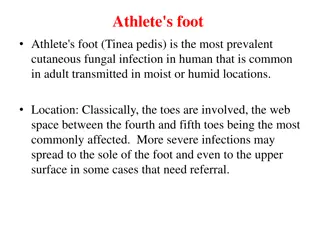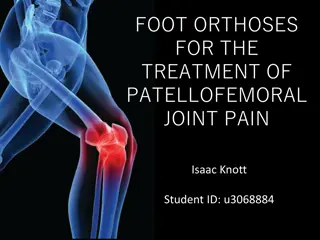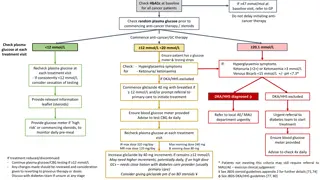Understanding Diabetic Foot Ulcers: Causes, Types, and Treatment
Diabetic foot ulcers are a common complication among diabetic patients, leading to disability and hospital admissions. The ulcers can be caused by factors like neuropathy and ischemia. Identifying the types, such as neuropathic and ischemic ulcers, helps in determining appropriate treatment, which may involve conservative debridement, dressing changes, and managing infections. Early detection and proper care are vital for preventing serious complications.
Download Presentation

Please find below an Image/Link to download the presentation.
The content on the website is provided AS IS for your information and personal use only. It may not be sold, licensed, or shared on other websites without obtaining consent from the author. Download presentation by click this link. If you encounter any issues during the download, it is possible that the publisher has removed the file from their server.
E N D
Presentation Transcript
Diabetic foot Assistant lecturer : Noor Wafaa Hashim
Definition Diabetic foot is a common chronic foot problems cause great disability within the diabetic patients. 10-15% of diabetic patients develop foot ulcers and foot related problems are responsible for up to 50% of diabetes related hospital admission.
Precipitating factors of foot ulceration Friction in ill-fitting or new shoes. Ulcerated callus. Self-treated callus. Foot injures (unnoticed trauma in shoes). Burns. Corn plaster. Nail infection. Foot deformities.
Causes of foot ulceration 1.Neuropathy: A. Peripheral neuropathy: is believed to be the most significant contributor to the development of lower extremity ulcers in diabetic patients through impaired detection of injury from poorly fitting shoes or trauma.
Causes of foot ulceration B. Autonomic neuropathy: leads to failure of sweating and inadequate lubrication of the skin. Dry skin leads to mechanical breakdown that initiates ulcer formation.
Causes of foot ulceration 2. Ischemia: the microvascular disease seen in diabetic patients also contributes to the development and progression of lower extermity . These patients should be evaluated for proximal atherosclerotic disease.
Types of foot ulceration Neuropathic : clinical features are: Warm with intact pulses Diminished sensation Ulceration Sepsis. Local necrosis Edema 1.
2. Ischemic(neuroishemic) clinical features: Pulses less, not warm. Usually diminished sensation. Ulceration Sepsis. Necrosis or gangrene. Critical ischemia (urgent attention foot pink, painful, pulse less, and often cold).
Treatment 1. conservative debridement and dressing changes, with careful trimming of the calluses and nails. 2. Infected wounds: are diagnosed clinically; excess keratin should be pared away to expose the floor of the ulcer and allow efficient drainage of the lesion. Clean wounds: are treated with
A bacterial swab should be taken from the floor of the ulcer after the callus has been removed. Plain X-rays may show osteomyelitis or gas in the soft tissues . The patient should be instructed to dress the ulcer daily. A simple non-adherent dressing should be applied after cleaning the ulcer with normal saline solution. Patients with superficial ulcers can be treated as outpatients and prescribed appropriate oral antibiotics until the ulcer has healed.
3. Urgent treatment: patients with redness and swelling of a foot; this often indicates a developing abscess , Cellulites, discoloration, and crepitus. Those patients need to be admitted to the hospital immediately for urgent therapy. They should have bed rest and be started on IV antibiotics. An IV insulin pump may be needed to control blood glucose level. In the 1st 24 hours before bacteriological cultures available, a wide spectrum of antibiotics cover is needed.
Prevention Careful selection of footwear. Daily inspection of the feet to detect early signs of poor-fitting footwear or minor trauma. Daily foot hygiene to keep the kin clean and moist. Avoidance of self-treatment of foot abnormalities and high-risk behavior. Promote consultation with a health care provider if an abnormality arises.

















































